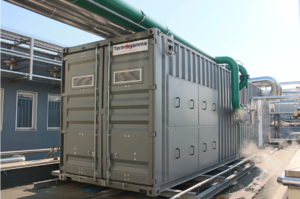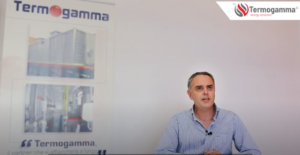Impianti di trigenerazione per usi industriali.
Principi di funzionamento della trigenerazione:
Trigenerazione, conosciuta anche con l’acronimo inglese CCHP – Combined Cooling Heat and Power (Combinazione di Freddo, Caldo e Potenza) – è in grado di generare tre tipi di energia. Oltre alla produzione di energia elettrica e termica (come nel caso della cogenerazione), produce anche energia frigorifera.
La tecnologia della Trigenerazione incorpora tutti i componenti presenti in un impianto di cogenerazione, più un refrigeratore ad assorbimento – l’elemento che permette la conversione del calore recuperato in energia frigorifera. Il sistema trigenerativo ha il suo cuore nel motore alimentato a gas naturale, questo può essere di due tipi: una turbina funzionante secondo il ciclo brayton-joule o un motore endotermico operante con ciclo otto.
Tramite un apposito alternatore viene trasformata l’energia meccanica proveniente dal motore in energia elettrica con rendimenti che in media di aggirano tra il 35 e 40%. Grazie a scambiatori ad altissima efficienza il calore viene recuperato dai fumi e dal corpo del motori e, successivamente, trasformato in energia frigorifera tramite gli assorbitori che rendono acqua fredda fino a 7 gradi centigradi, raggiungendo efficienze globali nell’ordine del 85/90%.
I refrigeratori ad assorbimento hanno diversi vantaggi, non avendo parti in moto, vita utile superiore ai 20 anni e utilizzando cascami termici di processo (in questo caso del motore a gas), rappresentano una delle tecnologie eco-friendly più utilizzate per la produzione di energia frigorifera.
Inoltre, queste macchine non utilizzano gas serra o reagenti con l’ozono, ragione per cui terminato il loro ciclo di vita non rilasciano nessuna emissione inquinante. Infatti, i liquidi refrigeranti utilizzati per far funzionare queste strutture sono diversi e solitamente a base di acqua, che come sopra indicato precedentemente, sono composti innocui per l’ambiente.
Vantaggi della trigenerazione:
Le centrali termoelettriche tradizionali convertono circa il 30% dell’energia del combustibile in elettricità e il restante 70% viene disperso in calore ceduto all’ambiente, con un trigeneratore più del 80% del combustibile viene sfruttato, sia in termini elettrici sia come energia atta ad un ciclo ad assorbimento per la refrigerazione di ambienti o fluidi.
In particolare possiamo elencare i seguenti vantaggi:
- Riduzione dei costi dell’energia del 30/40 %
- Riduzione del consumo del combustibile
- Riduzione impatto ambientale
- Riduzione delle perdite di energia per trasmissione
- Possibilità di usufruire degli incentivi statali
- Continuità e sicurezza degli approvvigionamenti energetici
Perche Termogamma:
Perchè Termogamma è un vero sarto di soluzioni energetiche, una società che mette avanti le persone e la cura dell’aspetto empatico di ogni relazione alla mera vendita, infatti, in 35 anni di sviluppo ha sempre evidenziato e cercato di sviluppare in maggior misura le fasi che la contraddistinguo dagli altri player del settore, quali ascolto delle reali esigenze del cliente, totale flessibilità sulle soluzioni offerte e servizio di manutenzione studiato per generare relazioni durature e basate sulla fiducia.
Infatti, la politica aziendale di Termogamma, date le sue dimensioni, le permettono di seguire realmente il cliente attraverso i suoi dubbi, offrendogli in conclusione una soluzione unica e studiata appositamente per la sua realtà aziendale.
Termogamma si occupa di ogni aspetto e stadio del percorso che un cliente intraprende dopo la volontà di abbracciare una polita green, che quindi spazia dalla genesi dell’idea intenzionale di installare un impianto di trigenerzione alla cura di quest’ultimo fino alla morte della soluzione trigenerativa.




